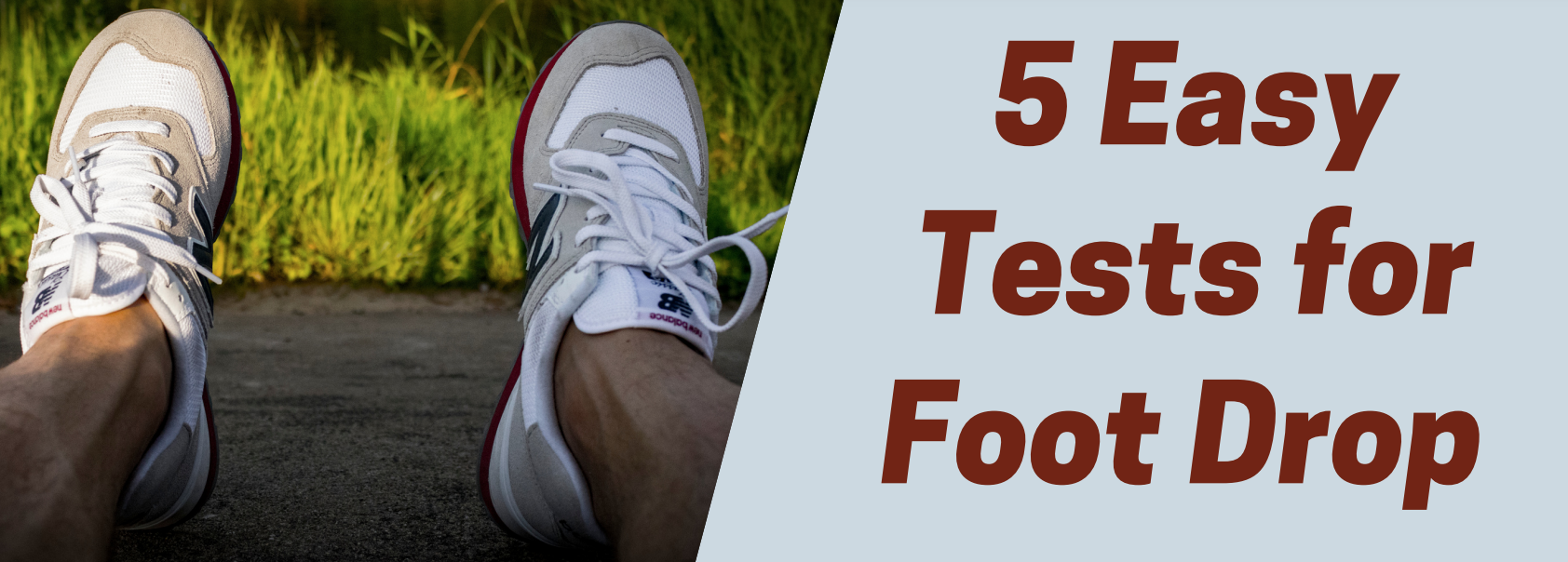5 Easy Tests for Foot Drop

Think you suffer from foot drop after a stroke or neurological injury? In this post, we will cover five easy tests to identify foot drop. Foot drop is a common symptom of many neurological and orthopedic issues affecting the lower leg. Most commonly, the peroneal nerve is the affected culprit, causing the lack of ability to lift the foot or toes off the ground. This could lead to a person dragging their foot as they walk, increase the risk of tripping or falling while walking, or cause the person to alter their steppage gait.
The following tests are simple tests that clinicians use to determine if foot drop, also known as drop foot, exists and if specialized tests by physicians are required for further analysis or diagnosis. These tests are easiest with an observer but can be performed alone by setting up a recording device with sound. In addition, click on the video below if you’d like to watch these tests in action.
Test #1 – Drag or Slap Test (Visual Observation)
To begin, the first test is the drag or slap test. This test requires an observer, or the test subject, to visually observe the way someone walks. This test has the viewer looking for the common symptoms of foot drop – a dragging foot or a foot that slaps the ground when walking. To test this, have the subject walk approximately 10 to 15 feet. Look for the foot to drag or for the foot to slap the ground when they take a step. Repeat if necessary. In addition, look for altered gait as well as balance deficits.
Test #2 – Heel Walk Test
Next, the second test is the heel walk test. For this test, have the subject attempt to walk on their heels for approximately 10 to 15 feet. For safety purposes, have the subject hold onto a countertop or use a device like a cane for balance and stability. Look for the subject to have trouble initiating the test, or they will be unable to keep their affected foot in the air the entire time. Do not attempt to test if your subject's balance is poor. A variation is standing at a counter on their heels and trying to hold toes off the ground. Look for the affected foot to not come off the ground or go back to the ground slowly.
Test #3 – Manual Muscle Test
The third test is the manual muscle test. This test is called a manual muscle (strength) test or MMT. This test can be performed with a clinician assisting you or can be alone. However, you may also find that using the handle of a cane can help you complete this test if you cannot reach your toes, have an altered sitting balance, or are alone.
To perform this test, you will need to sit in a chair with your affected leg stretched out in front of you. Start by trying to lift your toes and foot off the ground. If you can lift the foot off the ground – assist the foot through its full range of motion, bringing the toes up towards the shin. Try to hold it there. If not performed successfully, this is a positive sign for foot drop. If you can hold the foot in that position, apply pressure on the top of the foot, checking to see if the foot needs moderate or less to break the holding position. In other words, this is a sign of weakness.
Test #4 – Step Up and Down Test
The fourth test is the step up and down test. This test requires good safety awareness and balance. The test should not be performed if the subject has poor balance or a high chance of falling. Please complete this test with a clinician or therapist. First, have the subject stand in front of a set of steps, holding on to the railing for support. Second, have them slowly step up and down a few times. After that, when they feel confident with this motion, increase the speed of stepping up and down. Look for the foot to drag or for the subject not clear the first step with their toes.
Test #5 – Jump Test
Finally, the last test is the jump test. This test requires good safety awareness and balance. This test should not be performed if the subject has poor balance or a high chance of falling. Please do not complete this test on your own. Complete the test with a therapist or clinician. To begin, while holding onto a counter for support, ask the subject to jump off the ground. Make sure to encourage getting off the ground. Therefore, if the subject is unable to perform this, that is a positive sign for foot drop.
Get Back on Your Feet
The video in this post is part of a series of foot drop videos on our YouTube Channel. Here at Saebo, we offer an innovative foot drop solution, the SaeboStep. The SaeboStep consists of a lightweight and comfortable foot drop brace that provides optimum foot clearance and support during walking. The SaeboStep was designed to replace uncomfortable, stiff, or bulky splints that go inside the shoe, as well as poorly manufactured braces designed for outside of the shoe that lack support and durability. Don't forget about all the free resources we offer on saebo.com.

All content provided on this blog is for informational purposes only and is not intended to be a substitute for professional medical advice, diagnosis, or treatment. Always seek the advice of your physician or other qualified health providers with any questions you may have regarding a medical condition. If you think you may have a medical emergency, call your doctor or 911 immediately. Reliance on any information provided by the Saebo website is solely at your own risk.



